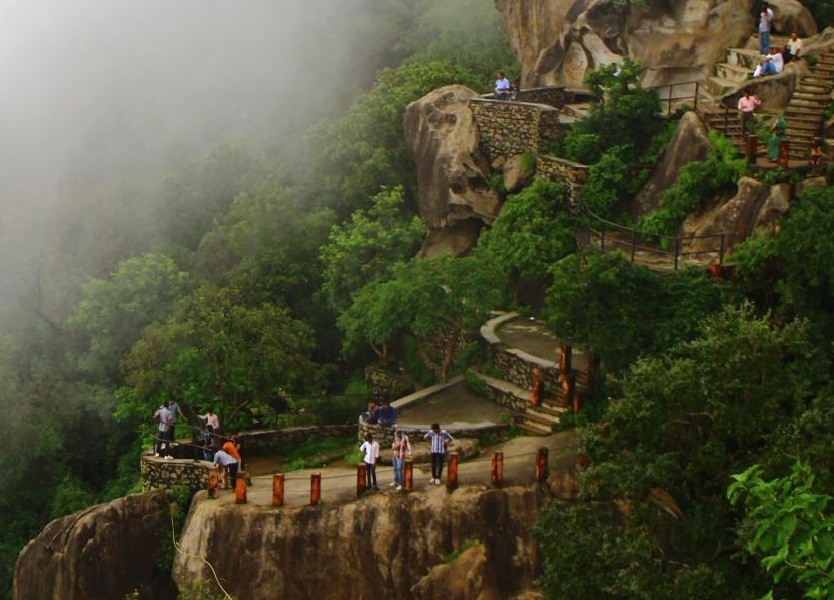Introduction
Welcome to the picturesque Mount Abu, a photographer’s utopia nestled in the Aravalli Range of Rajasthan, India. This guide is not just a list of places; it’s a journey into the heart of Mount Abu’s photogenic landscapes. Here, every corner tells a story, and every view begs to be captured. We’re here to unveil the most awe-inspiring photography spots that encapsulate the essence of Mount Abu’s natural beauty, cultural vibrancy, and architectural wonders. Whether you’re an amateur shutterbug or a seasoned pro, this guide promises to lead you to spots where you can capture not just images, but memories and experiences. For information on reaching this magnificent destination, check out Nearest Airports from Mount Abu.
The Enigmatic Beauty of Mount Abu
Mount Abu, the only hill station in Rajasthan, offers a refreshing contrast to the arid landscape of the region. Its lush greenery, cascading waterfalls, and misty mountains provide a perfect canvas for photographers. The fusion of nature with historical and religious significance makes Mount Abu a unique destination. Each photograph you take here tells a story of timelessness and beauty, making it a coveted destination for photographers and nature lovers alike.
The Charm of Mount Abu
A Symphony of Nature and Culture
Mount Abu, a jewel in the desert state of Rajasthan, is a symphony of natural splendor and rich cultural heritage. Its unique location in the Aravalli Range brings a burst of greenery and cool climate, a stark contrast to the surrounding desert. This hill station is not just a geographical wonder but also a cultural heartland, reflecting centuries of history, spirituality, and architectural brilliance.
The Green Oasis in the Desert
As you step into Mount Abu, the first thing that strikes you is its lush green environment. It’s like walking into an oasis where the air is fresher, and the scenery is a feast for the eyes. The verdant forests and the floral diversity are not just visually appealing but also a haven for nature lovers and bird watchers.
A Cultural Melting Pot
Mount Abu is a melting pot of cultures. Its historical significance is evident in the ornate temples and ancient forts that dot the landscape. The local markets bustle with the vibrant colors of traditional crafts and the sounds of folklore. Every corner of Mount Abu tells a story, every street resonates with the echoes of the past.
Top Photography Spots in Mount Abu
Mount Abu is a photographer’s paradise, offering a blend of natural beauty, architectural marvels, and cultural richness. Here are some spots that you must capture through your lens:
Nakki Lake – Reflections of Serenity
Nakki Lake, the heart of Mount Abu, is serene and scenic. Its calm waters reflect the changing colors of the sky and the surrounding hills, creating a mesmerizing effect. The lake is surrounded by unique rock formations and lush greenery, making it a perfect spot for landscape photography.
Sunset Point – A Palette of Hues
Witness the sky paint itself in vibrant hues at Sunset Point. As the sun dips behind the hills, the sky transforms into a canvas of oranges, pinks, and purples. This spectacle of nature is a must-capture for every photographer visiting Mount Abu.
Dilwara Temples – Marvels in Marble
The Dilwara Temples, renowned for their stunning marble architecture, are a testament to ancient craftsmanship. The intricate carvings and the play of light and shadow here offer countless opportunities for capturing architectural and cultural beauty.
Achalgarh Fort – Echoes of the Past
Perched on a mountain peak, Achalgarh Fort is a site of historical significance and architectural beauty. The fort provides panoramic views of Mount Abu and is an ideal spot for landscape and architectural photography.
Trevor’s Tank – A Natural Habitat
Trevor’s Tank is a nature lover’s paradise. This man-made tank, surrounded by dense forests, is a habitat for various species of birds and wildlife. It’s a perfect spot for wildlife and nature photography.
Tips for Capturing the Best Shots
Photography in Mount Abu is not just about finding the right spots; it’s about capturing the essence of the moment. Here are some tips to help you take stunning photos that speak volumes:
Embrace the Golden Hours
The golden hours, just after sunrise and before sunset, are magical in Mount Abu. The soft, diffused light enhances the landscapes and architectural features, creating a dreamlike quality in your photos. These hours are perfect for capturing the serene beauty of Nakki Lake or the splendid hues at Sunset Point.
Experiment with Perspectives
Challenge yourself to see beyond the obvious. Try different angles and perspectives to bring a unique touch to your shots. Low angle shots of Dilwara Temples or wide-angle views from Achalgarh Fort can create an impactful visual narrative.
Pay Attention to Composition
Good composition is key to great photography. Use the rule of thirds, leading lines, or framing to add depth and interest to your photos. For instance, the natural framing of trees around Trevor’s Tank can add an intriguing element to your wildlife shots.
Capture the Essence of Culture
Mount Abu is not just about landscapes; it’s a cultural hub. Capture the essence of local life, the vibrant markets, and the spiritual ambiance of the temples. These candid shots often tell more profound stories.
Be Patient and Observant
Great shots don’t happen in a hurry. Be patient, observe your surroundings, and wait for the right moment. Sometimes, the most mesmerizing photos are captured when you least expect them.
Respect the Environment and Culture
While you capture the beauty of Mount Abu, it’s crucial to respect its environment and culture. Be mindful of the local customs, especially when photographing religious sites, and ensure that your presence does not disturb the natural habitat.
Conclusion
In conclusion, Mount Abu is more than just a hill station; it’s a treasure trove of picturesque landscapes and architectural marvels. Through this guide, we hope to have inspired you to explore and capture the myriad beauties of Mount Abu. Each photography spot mentioned here offers a unique glimpse into the soul of this enchanting place. As you pack your camera and gear, remember that every shot you take is a piece of Mount Abu’s story, a fragment of its legacy that you get to keep forever. So, let your lens be your guide and your imagination your companion as you set out to capture the unforgettable vistas of Mount Abu.
FAQs
1.What is the best time of year to visit Mount Abu for photography?
Spring and autumn offer pleasant weather, making them ideal for photography.
2.Are there any photography workshops available in Mount Abu?
Yes, several local photographers and tour operators offer photography workshops.
3.Is a permit required for photography in Mount Abu?
For general photography, no permit is needed. However, specific sites may require permissions.
4.Can I use a drone for aerial photography in Mount Abu?
Drone usage is subject to local regulations. It’s best to check with authorities beforehand.
5.Are there any restrictions on photography at religious sites?
Yes, some temples may have restrictions. It’s advisable to check the rules at each site.






